The first Soviet ABM
 Bashny.Net
Bashny.Net
In 1945 - 1946 years. under the direction of LI Gutenmakher first electronic analogue machines with repetition solutions have been developed. But in 1949 the Soviet team of developers headed by VB Ushakov and VA Trapeznikov, invented a series of AVM DC. Since this year began the history of the development of analog computers in the Soviet Union. The use of operational amplifiers, which worked on the principle of automatic control systems with deep negative feedback, has made it possible to carry out an accurate simulation of mathematical operators, as well as parallel processing of real-time information for solving systems of differential equations.

beginning of future developments and in 1949 the Laboratory of electrical analogy of ITM CT and department chief designer Penza plant itself BA Matkina electron tube integrator ELI-12 was released. It was intended to solve the system of differential equations 12 order with constant coefficients and a constant term. The process of solving the problem is automatically repeated, in consequence of that decision results are displayed, measured and photographed on the CRT screen.
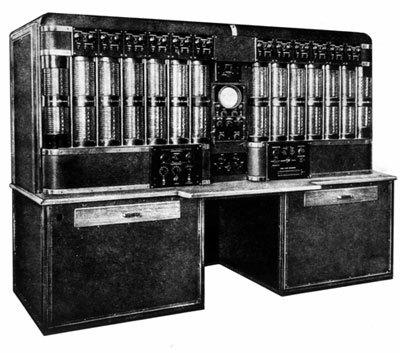
Revised schemes and design of electron tube of the integrator, as well as preparation for industrial production, the plant has begun mass production of ELI-12-1.
His constructive scheme-based integrator ELI-14 was developed, which solved the sixth-order differential equations. There are 6 crucial blocks. neoleykorit used, which are characterized by high insulation properties for the manufacture of switching tubes.
In 1949-1950 gg. in SRI-885 team headed by VB Ushakov's first AVM, called integrators DC were created. In 1949 - "IPT-1", "IPT-2" and "IPT-3" in 1950 - "IPT-4" and "IPT-5", are mass-produced. These machines are intended for the solution of linear differential equations with constant and variable coefficients. Due to operational amplifiers AVM provides a solution to the most important tasks in different scientific and technical areas (aircraft, rocket, space research, defense industry, etc..).
AVM first vacuum tubes were created combined efforts of two groups: RI-855 MCI and IAT USSR Academy of Sciences. Serial production of AVM was organized at Moscow, Penza and Chisinau plants accounting machines and a number of other factories radio.
Developed in the 1952-1953 biennium. under the direction of VB Ushakov AVM received the name "DC installation modeling" (MAT). the first Soviet high-power precision AVM has been developed for solving nonlinear differential equations
"MN-8" in 1955 "- Serial AVM" MPT-9 "were intended for the solution of linear differential equations," MPT-11. " MH-8. " It is the largest non-linear mathematical electronic machine of continuous action. The development team headed by VB Ushakov. Machine had to solve differential equations of the sixteenth and higher order (32 integrating unit). In the case of the sixteenth order to use half of the linear part.

Electronic simulator consisted of 13 sections. Tasks were recruited with the help of cord soedineniyay on switching fields of the linear part. Through a pair of control panels, simultaneously addressed two different tasks. The maximum duration of the integration process reached 10 000 seconds, and the power consumption was 25 kW.
"MN-8" carried out 48 transactions summing 264 terms, 48 multiplications by a constant factor, 36 multiplications a variable rate, 12 precision multiplications required quantities. There was also the possibility of a set of 10 non-linear dependence of functions of one variable, nonlinear dependencies 40 type signature, 9 nonlinear dependencies typical characteristics (backlash limitation, the dead zone).
In the car, there were 400 operational amplifiers with individual zero automatic stabilization and improved diagram of control. A powerful amplifiers with an economical yield was interaction with the real equipment. In the control circuit had more control.
Compared with only three overseas could sample the Soviet model:
- American elektromodeliruyuschaya installation "Typhoon» (Typhoon), released in 1951 .;
- English elektromodeliruyuschaya installation "Tridak (« Trydac »- Three Dimensional Analogue Computer), was created in the period 1950 - 1954. It was our electronic-hydraulic simulator, with which studied the shells management;
- American setting "Konvayr» ( «Convair»), issued in 1954
Feature of "MN-8" was the fact that the duration of the process, the test installation in real-time, it could be a small value (equal to a few seconds), and very large.
Driving integrating unit accelerated the expansion process, it allows you to automatically change the time scale at the same time for all of 10 times the installation units.
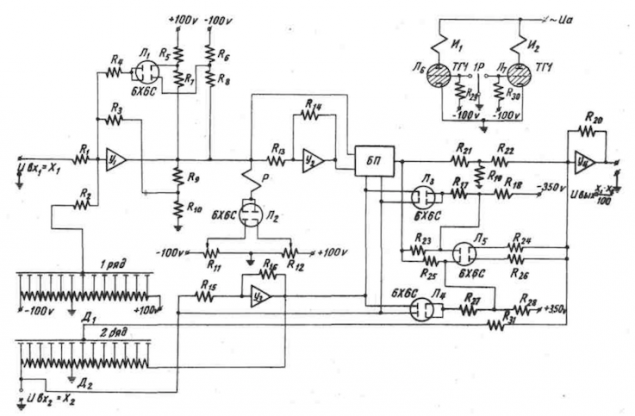
In "MN-8" blocks used precision multiplication. They were given the opportunity to receive a static accuracy of the multiplication operations of about ± 0, 01%. The number of blocks in the machine allowed to receive 12 transactions accurately multiplying variables.
The structure of "MN-8" consisted of 48 blocks for accurate input of variable coefficients, virtually reproduced the graph of variable coefficient by piecewise linear approximation. Also included 40 special nonlinear blocks to perform non-linear dependence of the type of signature. This improvement greatly expanded the capabilities of the machine.
Soviet elektromodeliruyuschaya plant had improved control scheme. On the basis of the electronic unit time meter it was built decimal digital counter. With it, synchronize the work of all the functional blocks. Process solutions may be repeated periodically, or to stop at predetermined time intervals.
In "MN-8" used diode-triode circuitry for universal blocks, which were intended for reproduction of non-linear functions of one variable with an accuracy of ± 0 set of functions, 2.
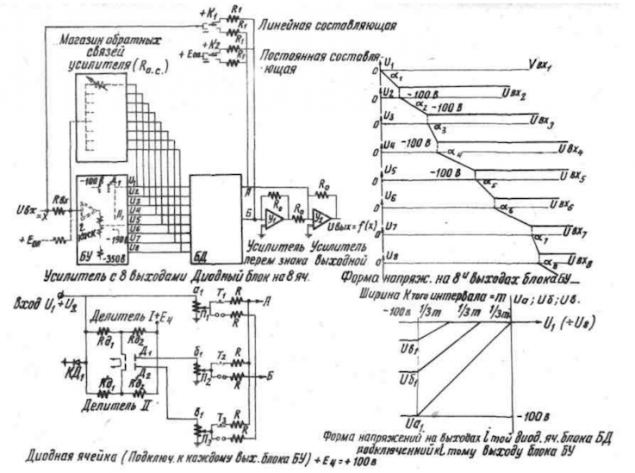
The unit allows you to type very fast edges functions and features with sharp kinks.
Simulated system of equations recruited in accordance with the block diagram of a solution to the problem of switching to fields that were on the sections of linear blocks installation. Trunk lines between the sections were allowed to use in a problem blocks of adjacent sections. In "MN-8" was not removable switching fields.
Registration and control output variables were carried out using the six-speed electronic potentiometers, the digital voltmeter, electron-beam indicator, and other measuring devices.
The "MN-8" has 14 counters. The compact design of the apparatus used blocks, so that it was relatively compact. Driving elektromodeliruyuschey installation housed many high-quality electrical parts (they dramatically increased the accuracy of the work). For example, in the scheme of sections of power was used around 8000 germanium junction diodes.
"MN-8" commercially produced Penza plant itself.
"MN-9" in 1958 published an electronic simulator "MN-9." It was designed to study the dynamics of the main parts of the mechanism. He led the development of the chief designer IM Wittenberg.
The "PL-9" was a poster design. Use the radio buttons and knobs is located on the front panel of the machine, installed Safe Mode operation.
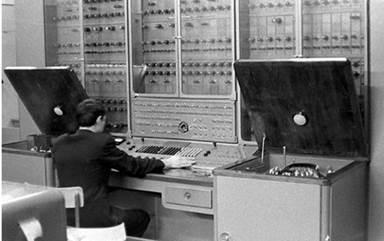
"PL-9" to solve systems of ordinary linear equations with variable coefficients. The unit employs 5 blocks summing amplifier, 40 units of constant coefficients and 9 blocks non-linear functions of one variable. The "PL-9" was 28 amps with automatic centralized installation of zeros on the circuit with capacitors and characterizing the presence of an electronic circuit for automatically switching the machine units in the target variable function.
Electronic simulator "MN-9" is not produced commercially
"MH-10" In 1957, there was a new development of Soviet specialists -. Small-sized nonlinear modeling tubeless setup "MH-10". It was the first analog computing machine with a scheme completely formed on the semiconductor elements. By setting investigated and solved the problem that is described by ordinary nonlinear differential equations. For example here is this:

Where i = 1, 2, ..., 6.
Including installation made it possible to solve differential equations, which contained up to 6 non-linear functions of the form functions of one variable, or the product of two variables. The work could be carried out in real-time. Task results were shown on a cathode-ray display type I-5 or I-4.
The structure of "MN-10" consisted of 24 small operating dc amplifier. They carried out the operation of integration, differentiation, summation and scale transformations. Also diode 4 cells, which were used in the schemes reproducing typical nonlinear dependence of the form of the hysteresis loop, dry friction torque, and the deadband limits.
The unit occupied an area of 0, 3 m2, weighed 75 kg. Range changing the setting variables ranged from 30 V to 30 V. The duration of the process of integration was 200 seconds.
Meals "MH-10" received from the ESP-10 unit, included in its package. A mains power was applied to single-phase AC voltage of 220 V, 50 Hz. Power consumption is 100W.
In the 70's installation was the beginning of modernization and mass-produced.
"MH-10M" analog computer "MH-10M" was developed by the Penza plant. The invention relates to small-sized desktop machines of small capacity, by means of which investigated the real dynamic systems by mathematical modeling. Also, "MH-10M" was intended for integration of ordinary differential equations of order no higher than tenth.
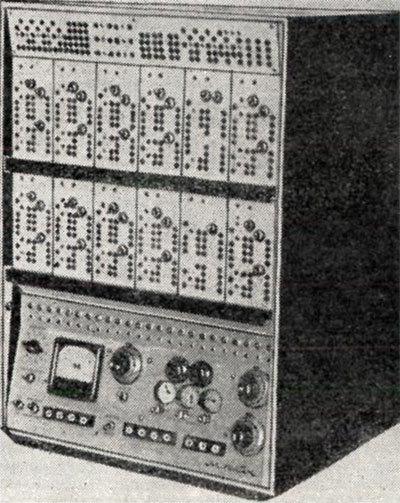
Dimensions of the machine is 460 × 615 × 445 mm, and weight -. 50 kg. The structure of "MN-10M" included 24 operational amplifier, and a set of 12 feedbacks.
Because of kit operating units could perform various operations:
- Integration operation while summing (10);
- Or inverting summing operation (24);
- Reference to the voltage divider (60 constant coefficients);
- Play one continuous nonlinear functions of one variable with simultaneous summation of several variables;
- Operation of multiplication or division with simultaneous summation of several variables;
- Play up to 6 types of non-linear functions of the form deadband limits, dry friction;
- Operation conditional transfer (up to 4)
. More complex problems were solved in parallel by two or three machines "MN-10M." Observe and measure the result of the problem could be on the dial instrument machine or an external recording instrument (ANC EPP-09 loop oscillograph). In part, they were not part of the machine.
It provided for interfacing with external equipment. Meals "MH-10M" was received from the ESP-4 unit, which was part of her set. A mains power was applied to single-phase AC voltage of 220 V, 50 Hz. Power consumption of 250 watts. Driving the machine and the power supply has been completely built on semiconductor elements.
Machine solved ordinary differential equations. The range of change of variables was from - 25 V to + 25 V. The duration of the process of integration was 200 seconds
. Block "MH-10M" include electronic stabilized rectifier (ESP-4), an analog computer communications machine (ABM), the communication channels with the external apparatus, with the second and third machine.
More than 100,000 AVM was manufactured for the first 20 years. From the simplest to the most powerful, such as "MN-8". The first time the car was used mostly in the form of independent means of mathematical modeling of dynamic objects in real time. But about 60-70 advances in digital electronics required joint information processing AVM and DCM.
Source: geektimes.ru/company/ua-hosting/blog/271086/

beginning of future developments and in 1949 the Laboratory of electrical analogy of ITM CT and department chief designer Penza plant itself BA Matkina electron tube integrator ELI-12 was released. It was intended to solve the system of differential equations 12 order with constant coefficients and a constant term. The process of solving the problem is automatically repeated, in consequence of that decision results are displayed, measured and photographed on the CRT screen.

Revised schemes and design of electron tube of the integrator, as well as preparation for industrial production, the plant has begun mass production of ELI-12-1.
His constructive scheme-based integrator ELI-14 was developed, which solved the sixth-order differential equations. There are 6 crucial blocks. neoleykorit used, which are characterized by high insulation properties for the manufacture of switching tubes.
In 1949-1950 gg. in SRI-885 team headed by VB Ushakov's first AVM, called integrators DC were created. In 1949 - "IPT-1", "IPT-2" and "IPT-3" in 1950 - "IPT-4" and "IPT-5", are mass-produced. These machines are intended for the solution of linear differential equations with constant and variable coefficients. Due to operational amplifiers AVM provides a solution to the most important tasks in different scientific and technical areas (aircraft, rocket, space research, defense industry, etc..).
AVM first vacuum tubes were created combined efforts of two groups: RI-855 MCI and IAT USSR Academy of Sciences. Serial production of AVM was organized at Moscow, Penza and Chisinau plants accounting machines and a number of other factories radio.
Developed in the 1952-1953 biennium. under the direction of VB Ushakov AVM received the name "DC installation modeling" (MAT). the first Soviet high-power precision AVM has been developed for solving nonlinear differential equations
"MN-8" in 1955 "- Serial AVM" MPT-9 "were intended for the solution of linear differential equations," MPT-11. " MH-8. " It is the largest non-linear mathematical electronic machine of continuous action. The development team headed by VB Ushakov. Machine had to solve differential equations of the sixteenth and higher order (32 integrating unit). In the case of the sixteenth order to use half of the linear part.

Electronic simulator consisted of 13 sections. Tasks were recruited with the help of cord soedineniyay on switching fields of the linear part. Through a pair of control panels, simultaneously addressed two different tasks. The maximum duration of the integration process reached 10 000 seconds, and the power consumption was 25 kW.
"MN-8" carried out 48 transactions summing 264 terms, 48 multiplications by a constant factor, 36 multiplications a variable rate, 12 precision multiplications required quantities. There was also the possibility of a set of 10 non-linear dependence of functions of one variable, nonlinear dependencies 40 type signature, 9 nonlinear dependencies typical characteristics (backlash limitation, the dead zone).
In the car, there were 400 operational amplifiers with individual zero automatic stabilization and improved diagram of control. A powerful amplifiers with an economical yield was interaction with the real equipment. In the control circuit had more control.
Compared with only three overseas could sample the Soviet model:
- American elektromodeliruyuschaya installation "Typhoon» (Typhoon), released in 1951 .;
- English elektromodeliruyuschaya installation "Tridak (« Trydac »- Three Dimensional Analogue Computer), was created in the period 1950 - 1954. It was our electronic-hydraulic simulator, with which studied the shells management;
- American setting "Konvayr» ( «Convair»), issued in 1954
Feature of "MN-8" was the fact that the duration of the process, the test installation in real-time, it could be a small value (equal to a few seconds), and very large.
Driving integrating unit accelerated the expansion process, it allows you to automatically change the time scale at the same time for all of 10 times the installation units.

In "MN-8" blocks used precision multiplication. They were given the opportunity to receive a static accuracy of the multiplication operations of about ± 0, 01%. The number of blocks in the machine allowed to receive 12 transactions accurately multiplying variables.
The structure of "MN-8" consisted of 48 blocks for accurate input of variable coefficients, virtually reproduced the graph of variable coefficient by piecewise linear approximation. Also included 40 special nonlinear blocks to perform non-linear dependence of the type of signature. This improvement greatly expanded the capabilities of the machine.
Soviet elektromodeliruyuschaya plant had improved control scheme. On the basis of the electronic unit time meter it was built decimal digital counter. With it, synchronize the work of all the functional blocks. Process solutions may be repeated periodically, or to stop at predetermined time intervals.
In "MN-8" used diode-triode circuitry for universal blocks, which were intended for reproduction of non-linear functions of one variable with an accuracy of ± 0 set of functions, 2.

The unit allows you to type very fast edges functions and features with sharp kinks.
Simulated system of equations recruited in accordance with the block diagram of a solution to the problem of switching to fields that were on the sections of linear blocks installation. Trunk lines between the sections were allowed to use in a problem blocks of adjacent sections. In "MN-8" was not removable switching fields.
Registration and control output variables were carried out using the six-speed electronic potentiometers, the digital voltmeter, electron-beam indicator, and other measuring devices.
The "MN-8" has 14 counters. The compact design of the apparatus used blocks, so that it was relatively compact. Driving elektromodeliruyuschey installation housed many high-quality electrical parts (they dramatically increased the accuracy of the work). For example, in the scheme of sections of power was used around 8000 germanium junction diodes.
"MN-8" commercially produced Penza plant itself.
"MN-9" in 1958 published an electronic simulator "MN-9." It was designed to study the dynamics of the main parts of the mechanism. He led the development of the chief designer IM Wittenberg.
The "PL-9" was a poster design. Use the radio buttons and knobs is located on the front panel of the machine, installed Safe Mode operation.

"PL-9" to solve systems of ordinary linear equations with variable coefficients. The unit employs 5 blocks summing amplifier, 40 units of constant coefficients and 9 blocks non-linear functions of one variable. The "PL-9" was 28 amps with automatic centralized installation of zeros on the circuit with capacitors and characterizing the presence of an electronic circuit for automatically switching the machine units in the target variable function.
Electronic simulator "MN-9" is not produced commercially
"MH-10" In 1957, there was a new development of Soviet specialists -. Small-sized nonlinear modeling tubeless setup "MH-10". It was the first analog computing machine with a scheme completely formed on the semiconductor elements. By setting investigated and solved the problem that is described by ordinary nonlinear differential equations. For example here is this:

Where i = 1, 2, ..., 6.
Including installation made it possible to solve differential equations, which contained up to 6 non-linear functions of the form functions of one variable, or the product of two variables. The work could be carried out in real-time. Task results were shown on a cathode-ray display type I-5 or I-4.
The structure of "MN-10" consisted of 24 small operating dc amplifier. They carried out the operation of integration, differentiation, summation and scale transformations. Also diode 4 cells, which were used in the schemes reproducing typical nonlinear dependence of the form of the hysteresis loop, dry friction torque, and the deadband limits.
The unit occupied an area of 0, 3 m2, weighed 75 kg. Range changing the setting variables ranged from 30 V to 30 V. The duration of the process of integration was 200 seconds.
Meals "MH-10" received from the ESP-10 unit, included in its package. A mains power was applied to single-phase AC voltage of 220 V, 50 Hz. Power consumption is 100W.
In the 70's installation was the beginning of modernization and mass-produced.
"MH-10M" analog computer "MH-10M" was developed by the Penza plant. The invention relates to small-sized desktop machines of small capacity, by means of which investigated the real dynamic systems by mathematical modeling. Also, "MH-10M" was intended for integration of ordinary differential equations of order no higher than tenth.

Dimensions of the machine is 460 × 615 × 445 mm, and weight -. 50 kg. The structure of "MN-10M" included 24 operational amplifier, and a set of 12 feedbacks.
Because of kit operating units could perform various operations:
- Integration operation while summing (10);
- Or inverting summing operation (24);
- Reference to the voltage divider (60 constant coefficients);
- Play one continuous nonlinear functions of one variable with simultaneous summation of several variables;
- Operation of multiplication or division with simultaneous summation of several variables;
- Play up to 6 types of non-linear functions of the form deadband limits, dry friction;
- Operation conditional transfer (up to 4)
. More complex problems were solved in parallel by two or three machines "MN-10M." Observe and measure the result of the problem could be on the dial instrument machine or an external recording instrument (ANC EPP-09 loop oscillograph). In part, they were not part of the machine.
It provided for interfacing with external equipment. Meals "MH-10M" was received from the ESP-4 unit, which was part of her set. A mains power was applied to single-phase AC voltage of 220 V, 50 Hz. Power consumption of 250 watts. Driving the machine and the power supply has been completely built on semiconductor elements.
Machine solved ordinary differential equations. The range of change of variables was from - 25 V to + 25 V. The duration of the process of integration was 200 seconds
. Block "MH-10M" include electronic stabilized rectifier (ESP-4), an analog computer communications machine (ABM), the communication channels with the external apparatus, with the second and third machine.
More than 100,000 AVM was manufactured for the first 20 years. From the simplest to the most powerful, such as "MN-8". The first time the car was used mostly in the form of independent means of mathematical modeling of dynamic objects in real time. But about 60-70 advances in digital electronics required joint information processing AVM and DCM.
Source: geektimes.ru/company/ua-hosting/blog/271086/
Tags
See also
Seymour Cray and his car
Talk to your car: how Your computer and phone know what You want them to do
Gidrointegrator Lukyanov
The fatal flaw of the USSR
UAZ: unknown machines, ahead of their time
Another review of the private collection of rare computing
Alex garland: people ruin everything; the machines a pretty good track record compared to us
Washing machine without water
10 most feared military machines of all time Russia
How the computer

















